BEMC Noise Tests
Oleg and Stephen took a 5K event run with BEMC JP trigger set at threshold = 27 and all HV off on PMTs. The parameters for run 15177022 wereTCD phase 119, jp0 trigger threshold 27, pre/post 4. Eleanor analyzed this data and found evidence of noise at the DSM level. In an effort to isolate the origin of the noise we looked at the output of the trigger emulator on the raw BEMC data to see if the raw data would have fired the JP=27 adc threshold. Here are the steps we followed:
1) Kevin downloaded the raw data files from HPSS :
gpfs01/star/i_uky/jkadkins/bemcNoise2014/daq/st_physics_15177022_raw_0000001.daq
gpfs01/star/i_uky/jkadkins/bemcNoise2014/daq/st_physics_15177024_raw_0000001.daq
gpfs01/star/i_uky/jkadkins/bemcNoise2014/daq/st_physics_15177035_raw_0000001.daq
gpfs01/star/i_uky/jkadkins/bemcNoise2014/daq/st_physics_15177036_raw_0000001.daq
2) Kevin produced MuDst files from the .daq files using chain given by Lidia:
"ry2014a,in,AgML,UseXgeom,tpcDB,Event,l0,trgd,ZDCvtx,eemcDb,emcDY2,CMuDst,analysis,evout"
/gpfs01/star/i_uky/jkadkins/bemcNoise2014/MuDst/st_physics_15177022_raw_0000001.MuDst.root
/gpfs01/star/i_uky/jkadkins/bemcNoise2014/MuDst/st_physics_15177024_raw_0000001.MuDst.root
/gpfs01/star/i_uky/jkadkins/bemcNoise2014/MuDst/st_physics_15177035_raw_0000001.MuDst.root
/gpfs01/star/i_uky/jkadkins/bemcNoise2014/MuDst/st_physics_15177036_raw_0000001.MuDst.root"
3) OFFLINE PEDESTALS were determined from the 15177022. The most standard way to run the trigger emulator is with pedestals determined offline so Suvarna produced Pedestal_15177022.txt file (attached below) from 15177022 Mudst. Note that the determination of the official offline pedestals have not been completed so Suvarna simply filled a histogram for teach tower and used the bin with maximum counts as the pedestal. This is extremely simple but works fine in this case because the high voltage was off. Suvarna also produced plots of ADC correlations between channels in a trigger patch - see bottom for details.
4) ONLINE PEDESTALS were loaded by Kevin. These are the pedestals that are used in the FEE. I verified they are the same as the ones in the bemcStatus.txt attached at the bottom.
5) Kevin loaded the trigger data from the 2014 run to the database. The trigger data includes FEE LUT parameters and BEMC FEE tower masks. These were used in all plots
6) I verified FEE parameters in 5) were being correctly loaded into the trigger emulator for the 15177022 MuDst. The following plots are output from the StTriggerUtilities package (run macro ~rfatemi/Noise/MuDstBemcAccess.C) Note that tower 3485 was not masked at the FEE level but was found to be stuck at 4096 in the data stream and was masked out in addition to FEE tower masks (see plot at bottom). Also note that plot B&C and D&E are the same plots but run with OFFLINE&ONLINE pedestals for comparison.
A) Verify that the trigger data into the layer 0 DSMs from the BEMC FEES in the MuDst gives the same results as the online data. Data looks the same.
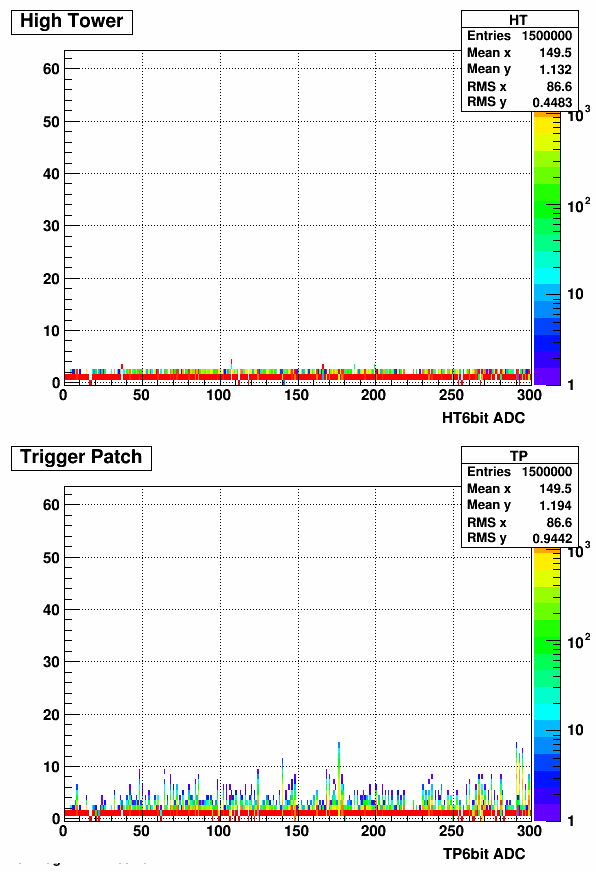
B) Now compare the 6bit Trigger Patch ADCs from the trigger emulator (top) WITH OFFLINE PEDESTALS from Pedestal_15177022.txt file and from the trigger data above (bottom). The 6bit TP adcs from the data stream look as expected for a run with PMTs turned off - all patches are at pedestal. The 6bit TP adcs from the trigger side of the FEEs look noisy.

C) Now compare the 6bit Trigger Patch ADCs from the trigger emulator (top) WITH ONLINE PEDESTALS from bemcStatus.txt file and from the trigger data above (bottom). Now the 6bit TP adcs from the data stream look the same as those in the trigger data.
.png)
D) Next look at the Jet Patch ADC values from the emulator using the OFFLINE PEDESTALS (Pedestals_15177022.txt). The pedestals hover around 6-10 but never exceed 27. The trigger emulator reconstructs no JP triggers from the data stream.
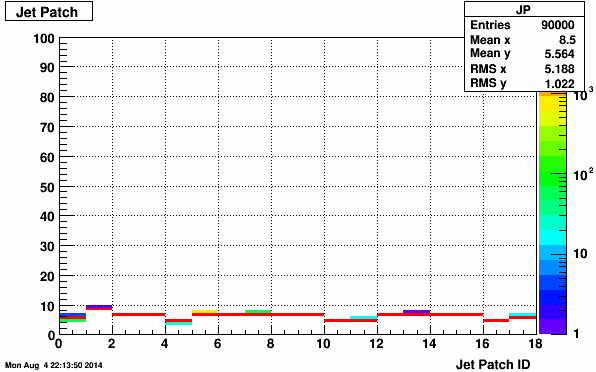
E) Now look at the JP adc with the ONLINE PEDESTALS (bemcStatus.txt) and we see something much more in agreement with what Eleanor saw.
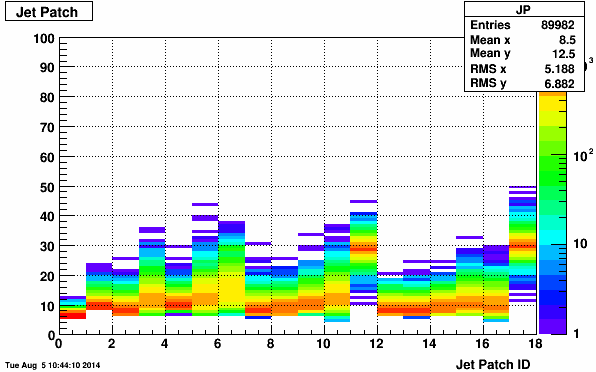
F) Finally just for good measure here is the JP adc spectrum with OFFLINE PEDESTALS and tower 3485 were NOT masked. The TP 262 would be pegged and JP's 10 and 16 would be consistently high:
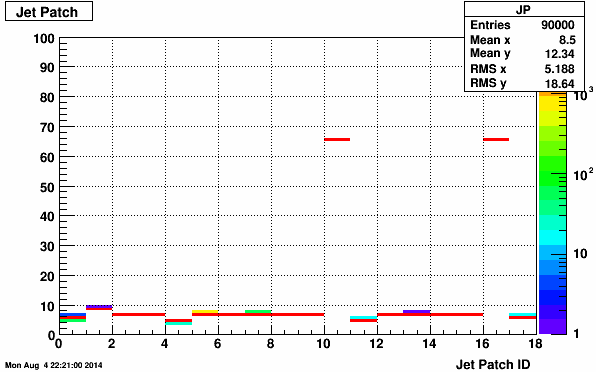
Although I have made every effort to ensure the offline StTriggerUtilities suite is set up correctly, it is a large and complex set of code and has not been vetted for 2014 running. Therefore Suvarna created a macro that plotted the raw adc values for each of the towers, as well as correlations between towers, within a given trigger patch. She is producing a pdf for each trigger patch and storing them at http://www.star.bnl.gov/protected/spin/sra233/Noise/. As an example take a look a the pdf for trigger patch 4. This file has three pages:
page 1: The raw ADC for 5K events for each of the 16 towers within the trigger patch
page 2: The raw ADC versus event number for each of the 16 towers within the trigger patch. Towers are offset vertically by 25 channels.
page 3: ADC correlations between the first tower input (lowest sequence number) into the trigger patch and each of the 16 towers in the trigger patch.
There is no evidence of correlated ADCs in any of the trigger patches.
_______________________________________________________________________________________________________________________________________________________
Plots of online and Suvarna's offline pedestals (not offline pedestals from the database), as well as comparisons between the two may be found at : http://www.star.bnl.gov/protected/spin/rfatemi/Noise/ . On average there appears to be a difference of 4 channels between the online and Suvarna's offline pedestals.
________________________________________________________________________________________________________________________________________________________
PART II
Gerard asked if I could reproduce the noise in the offline spectra by subtracting (or adding) 4 adc channels uniformly to the offline pedestals. This on average would move them to the range of the online pedestals. The plots below show the emulated (top) and trigger bank (bottom) TP adc spectrum:
CASE 1) Plus4 - very similar to default offline pedestals but more entries below the pedestal
CASE 2) Minus4 - noise emerges
CASE 3) Plus8 - all peds move to zero
CASE 4) Minus8 - noise enhanced
____________________________________________________________________________________________________________________________________________
Tonko used his BEMC pedestal calculation to test if changing the clock used to take pedestals resulted in a change in the pedestal value. His results (shown below in Figure G) indicate there is some clock dependence but it is on the order of channel - not the 4 channel difference we see between Suvarna's and online pedestals.
Figure G:

In order to remove the possibility that Tonko's pedestals are calculated differently from Suvarna's pedestals I asked Tonko to produce a pedestal file for run 15177022 (see BEMC_pedestals_15177022.txt) attached below. Suvarna compared her pedestals (Pedestal_15177022.txt ) with Tonko's peds and plotted the diffference in Figure H below. Note that Suvarna's pedestals are stored as a function of softId while Tonko's pedestals are stored as a function of
daq_crate_ix daq_crate_ch daq_id ped rms
where his daq_id is determined by the formula:
daq_id = (btow_crate_id-1)*160+daq_crate_ch+1
Suvarna's pedestals are systematically higher than Tonko's pedestals by 1 channel. Quick investigation confirms this offset is in fact artifical. Suvarna uses the bin# of the bin with the maximum counts as the pedestal. Because her histograms have 4096 bins and are binned from -0.5 to 4095.5 then bin#1 corresponds to a mean pedestal of 0 and bin #10 corresponds to a mean pedestal of 9. So in fact, up till now Suvarna's pedestals were systematically high by 1 channel. This will remove the offset and result in excellent agreement between Tonko and Suvarna's offline pedestals.
Figure H:
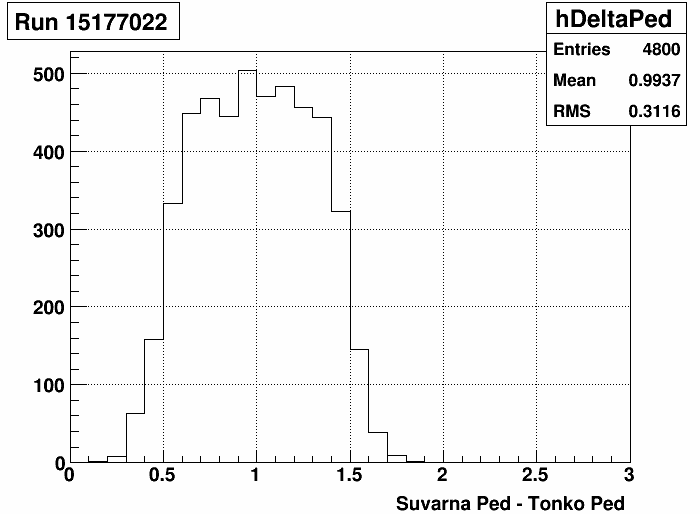
- rfatemi's blog
- Login or register to post comments
